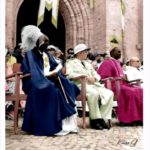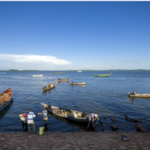The Central Court: Myth Of Origin II
The Queen Mother
Although the Mwami’s powers were absolute he shared his prerogatives with the queen mother. She ruled with the king, had her own court and her own personal clients on Ibikingi land. She had her own herds and she could intervene in court cases and pass judgement. Not only did she have her court close to the king’s but she always accompanied the king wherever he went, even on his military expeditions.
She was given the same honours as the Mwami and was called Mugabekazi. It may be noted that the king of Ankole, who claimed to be of the Bega clan, was called Mugabe. The same wordmugabe was used in Rwanda for the head bull of the royal herd and for the four royal drums.
The king and the queen mother were referred to jointly as the Bami of Rwanda which indicates that she really shared in the kingship. However in this partnership the king retained a dominant position and in fact the role of the queen mother depended on the king. This personal dependence became especially evident when the king died. At that moment she lost all her powers and became a normal subject.
When Musinga was sent into exile, the queen mother went with him. If the queen mother’s husband died, she could not remarry. Although the Nyiginya clan had the prerogative of endogamy, sons who were issues of endogamous unions were excluded from succession to the royal drum. The successor had to have a mother from a different clan. In practice the Bega clan had most often provided the queen mothers.
However within the Bega clan several lineages competed for this important privilege. Moreover five other clans had at different times provided the queen mothers. These six
clans with the royal clan and the abashambo and abahondogo constituted the nobility of Rwanda.
The abashambo and abahondogo however could not provide a queen mother as they were regarded as brother clans of the Nyiginga clan-(Pauwels I965 P-273). This possibility, open to a number of clans, of providing the queen mother implied a plurality of concomitant potential avenues of favour in relation to the king and the queen mother. This situation led to continuous competition among the important Tutsi lineages of the clans from whom the queen mother could be chosen. It also constituted a framework for divisions among possible opponents to the king’s power.
Like the Mwami, the queen mother dropped her Tutsi name and received a dynastic name, the same as that of the king with the prefix nyira: thus Nyirayuhi, Nyirakigeri. If his mother died the king had to be given another official “mother”. But in that case she had to be of the same lineage as his real mother. In case the realmother of the heir apparent died, the reigning Mwami had to give him a new official mother who could not in this case already have a son sired by the reigning Mwami. This shows that it was the lineage that had the right to produce the queen mother. The first rules made for stability in as much as they were a safeguard against the assassination of the queen mother being rewarded by giving the office of the queen mother to a different lineage.
Thesecondrule made for stability in as much as it prevented conflict between the king and the real son of the official queen mother. The wisdom of this rule was made evident when Rwabugiri (1853-1895) transgressed it and appointed Rutalindwa as his successor. His mother, who was of the Kono lineage of the Bega clan, had died and Rwabugirihad given him a new “mother”from the Kagaara lineage of the Bega clan. However she was Rwabugiri’s wife who had a son by him called Musinga. Soon after Rutalindwa’s accession, the Kagaara lineage saw an opportunity not only to have oneof their lineage as queen mother but also to have as king Musinga, issue of the queen mother. The obstacle was Rutalindwa himself. He was attacked and he committed suicide with his family. Only one son Ndungutse escaped to the North and challenged Musinga in a bloody revolt. Musinga obtained the help of the German troops and quelled the rebellion. However, the legitimacy of Musinga remained a matter of dispute, especially in the North and North-East, which had supported the person who pretended to be Ndungutse. It is against this background of intrigues related to the position of the queen mother, that we must see the introduction of the Tutsi chiefs and the imposition of the pattern of the administrative structure with the aid of German and Belgian military power in the peripheral areas of the North and North-East.
Pauwels (1967 P .230-233) gives details of the dates and places where for the first time Tutsi chiefs who had been faithful to Musinga and his mother were introduced into these areas and were supported by the Belgian forces. He concludes : « Il est donc incontestable que l’est aux Beiges que le roi du Rwanda était redevable de la stability de ses representants dans ces régions. Comme d’ailleurs aussi du remp lacement desBahinza par des chefs Batutsi ».
These facts not only show the importance and power of the position of the queen mother but also shed light on the actual relationship between the North and North-East and the court. It was the first king of each royal cycle, Cyirima or Mutara who determined in which lineages their successors had to find their wives who were to become queen mothers. This information was however kept secret even from the Biru and official councillors and was confided to a neutral ritualist (d’Hertefelt I964 p.334).
This institutionalised mechanism of rotation involved fluctuation in the possibility of political influence asbetween the various lineages of the nobility and resulted ina longer-term balance of power. It was both the element of secrecy and the pre-arranged pattern of lineages set at the beginning of the cycle which set limits on competition between the lineages, thus making for stability. The actual operation of this in reducing the extent of political competition would obviously be least effective at the end of a cycle, as for instance at the time of Musinga.
Within this context of the distribution of power and the uncertainty in the pattern of rotation, the Tutsi lineages concerned were however all foci of possible power positions and ties with them were important in the search for protection within the Rwanda system of social relationships. The division in the royal power structure inherent in the special position of the queen mother, constituted a check on the king’s absolutism in his relations with the nobility. On the other hand it reduced tensions between this absolutism and these lineages by creating both a sense of and actual avenues of participation in his kingship. Moreover it constituted a framework of hierarchical ranking of the nobility, based on actual and possible participation in the king’s power through the queen mother.
The changing power positions of the lineages, resulted in a certain amount of flexibility in the system since the actual status of the competing Tutsi families was precarious and their ability to distribute favours while holding their favourable power positions was accordingly temporary. The whole system of power-relations culminating in the queen mother constituted another avenue to obtain favour or justice and as such was a factor both in promoting and in containing tensions by being an alternative focus of power.
However when the Belgian Government deposed Yuhi Musinga and appointed Charles Mutara, the first of a new royal cycle, this traditional pattern was upset. This was furtherfinalised when Mutara married a member from a clan which had never provided a queen mother. Moreover the mother of Mutara was no longer allowed to live near the court but was forced to live in Kakanzi in the Marangara district.
The role of the queen mother had come to an end and with it went some of the flexibility in the political system. Moreover the reduction of the power of some of the lineages had the effect of increasing the power of the king.
The Biru
The next highest authority in the kingdom was the body of traditionalists, or royal councillors who were referred to collectively as the Ubwiru. Around 1900 there were ten abiru ‘Kagame 1947 p.366) (d’Hertefelt 1962 p.71). They were dignitaries holding different offices relating to the safe keeping and continuity of tradition. They werehierarchically ranked and all belonged to certain Tutsi lineages. The offices were ascribed and although the Mwami had the power to dismiss an umwiru for neglect or forgetfulness, the office stayed within the lineage. The office holder appointed his own successor within the lineage. Their office was rewarded not only by outstanding prestige but also by numerous privileges, the most important of which were their independence of the normal pattern of administration and their exemption from taxation. Because their office was hereditary within the lineage, the king’s power over them was very limited.
The nature of their office and the fact that theirs wasan ascribed status and one which was economically independent,made it one of the stable institutions in the political system of Rwanda. They were the ritualists necessary for the execution and timing of the royal rituals related tothe well-being and fertility of the king and the country. They moreover constituted the group of wise men, holdingthe body of knowledge required for the right behaviour of the king in the light of tradition.
They were the holders of tradition and the secret-knowledge relating to ritual succession and the interpretationof events. They kept the king’s will. In order to preventthem from divulging this secret knowledge the abiru wereobliged, at the time of initiation, to drink a potion which,it was believed, would automatically kill them if they tolda part of the secrets to outsiders.
The total body of knowledge however was only held by three members of the ubwiru. The others knew only parts of it. To prevent the knowledge from being forgotten or from being lost in case of accidental death, the abiru were allowed to have some of their lineage members as assistants whom they themselves chose and who again were put under the seal of secrecy by being administered the potion with itsautomatic sanction. Their function insured the continuity of the royal lineages and prevented the king from maiding too many innovations. They could effectively control the king because he needed their knowledge and assistance forhis ritual function. Their economic independence moreover prevented the king from exerting direct material pressures. Because their function was hereditary within certain Tutsi lineages end not only unassailable by the king or the queen mother but, by necessity, complementary to the kingship, it was a stable safeguard of the interests and power position of the important Tutsi descent groups. On the other hand, because of the hierarchical ranking and the complementary function of each of the lineages, and because of the stable power position of the ubwiru as a group in relation to the king, it formed a focus for political manoeuvring and the seeking of alliances. As such it was one more important channel for “politics” in the wider political system.
In 1931, when Charles Mutara III Rudahigwa was appointed king, he was given a council of four men of important Tutsi lineages to replace the ubwiru. Maquet and d ’Hertefelt (1959 P. l4) write:
« A cette époque, 1’intervention des autorittés belges se manifeste plus par des décisions de la sorte que par des reformes structurelles ».
The official function of the ubwiru came to an end and withit went another element of constraint on the king’s power and another avenue of political mobility.





